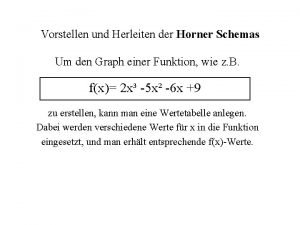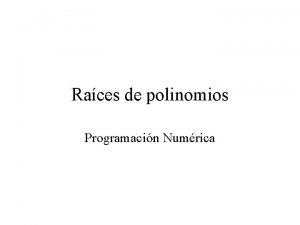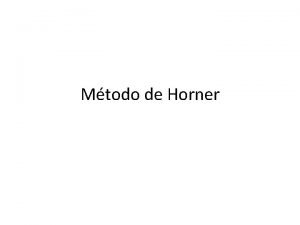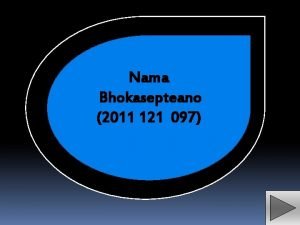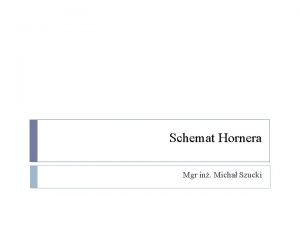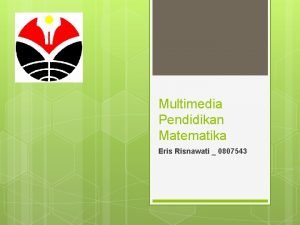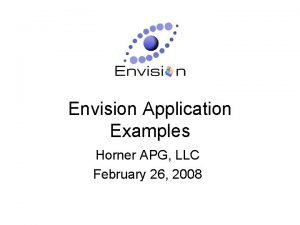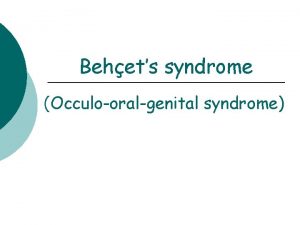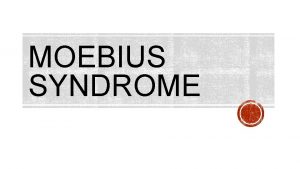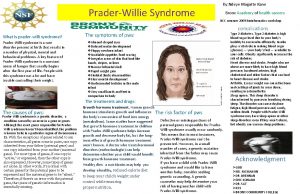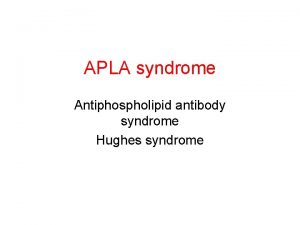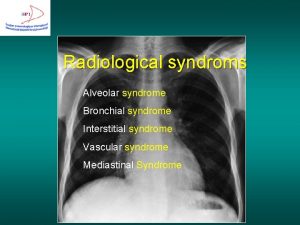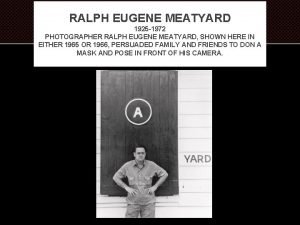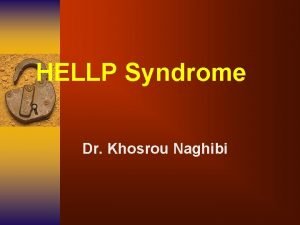Eyedrop testing in Horner Syndrome Eugene F May



































- Slides: 35

Eyedrop testing in Horner Syndrome Eugene F. May, MD Neuro-ophthalmic Consultants Northwest Seattle Neuroscience Institute at Swedish Medical Center University of Washington Seattle, WA

• Horner JF. Über eine Form von Ptosis. Klinische Monatsblätter für Augenheilkunde. 1869; 7: 193198. – No references – Described by Claude Bernard (1850) – Described by Francois Pourfour de Petit (1727)

Anatomy





Pharmacology


Findings • Ptosis – upper eyelid ptosis – inverse ptosis – narrowing of the palpebral fissure • facial anhidrosis • miosis – > 1. 0 mm – dilatation lag • any combination of the above – van der Wiel HL The diagnosis of Horner’s syndrome. Clin Neurol Neurosurg. 1988; 90: 103 -108.

Miosis • Ptosis – iris constrictor unopposed – 1 - 1. 5 mm miosis • greatest in dim illumination • dilation lag – pupil dilation is passive

Is there a chance combination of the ptosis and miosis? • No anhidrosis • No associated neurologic symptoms or findings

Historical Background • • Dilute epinephrine test Cocaine test Hydroxyamphetamine test Apraclonidine test

Cocaine test • Cocaine hydrochloride, 10% • one or two drops in each eye – perhaps several minutes apart • measure pupil size before and 50 -60 minutes later – maintain stable ambient lighting (what level? ) – control near response – ? measure post-drop anisocoria – ? measure change in anisocoria pre- vs. post-drop

Cocaine test • Normal eyes – post-cocaine anisocoria < 0. 5 mm – pupils of Afro-americans react poorly to cocaine – Friedman JR et al. The cocaine test in normal patients. Am J Ophthalmol. 1984; 98: 808 -810 • Horner syndrome – anisocoria of 1. 0 mm or more is consistent – normal result does not exclude Horner’s – Van der Wiel HL, Van Gijn J. The diagnosis of Horner’s syndrome: use and limitations of the cocaine test. J Neurol Sci. 1986; 74: 311316.

Cocaine test • Chances of a Horner syndrome increase with anisocoria – anisocoria of 0. 8 mm = odds ratio of 1050: 1 – anisocoria of 1. 0 mm = odds ratio of 6000: 1 • but measured anisocoria of up to 0. 9 mm in normals • anisocoria as little as 0. 3 mm in Horner group Kardon RH et al. Critical evaluation of the cocaine test in the diagnosis of Horner’s syndrome. Arch Ophthalmol. 1990; 108: 384 -387.

Cocaine test – Absolute anisocoria more predictive than change in anisocoria • less overlap between groups – physiologic anisocoria • anisocoria actually decreased in most Kardon RH et al. Critical evaluation of the cocaine test in the diagnosis of Horner’s syndrome. Arch Ophthalmol. 1990; 108: 384 -387.

Cocaine test Alternatives • Why not cocaine? – difficult to obtain (? ) – expensive (? ) – short shelf life (? ) – parents hesitant (? ) – positive urine test (? )

Cocaine test Alternatives • Apraclonidine 0. 5%, 1% (Iopidine) – α 2 > α 1 adrenergic agonist • approved for treatment of IOP after trabeculoplasty • receptors upregulate after 5 -8 days – reversal of anisocoria in several studies • 0. 5% and 1. 0% • denervation supersensitivity – actively dilates the abnormal pupil

Apraclonidine • Studies show good sensitivity – 1. 00 (1%) and 0. 88 (0. 5%) – Morales J et al. Arch Ophthalmol. 2000; 118: 951 -954. – Brown SM et al. Arch Ophthalmol. 2003; 121: 1201 -1203. – physiologic anisocoria: no reversal of anisocoria • Comparison studies – 0. 5% vs 4% cocaine in children • equally sensitive • Chen P et al. J Ocular Pharm and Therapeutics. 2006; 22: 182 -187.

Apraclonidine • must have high level of illumination • sometimes normal pupil dilates

Apraclonidine • Side effects – in children with glaucoma • apnea, bradycardia, hypotension, somnolence, fatigue – in children with Horner syndrome • conjunctival hyperemia • sleepiness

Localization

Hydroxyamphetamine test • Pivotal study – more reliable than dilute epinephrine testing – Thompson HS and Mensher JH. Adrenergic mydriasis in Horner’s syndrome. Hydroxyamphetamine test for diagnosis of postganglionic defects. Am J Ophthalmol 1971; 72: 472 -480.

Hydroxyamphetamine test • Post-drop anisocoria – difference in dilation • 1. 0 mm: 85% chance of post-ganglionic lesion • 1. 5 mm: 96% chance of post-ganglionic lesion Cremer SA, et al. Hydroxyamphetamine mydriasis in Horner’s syndrome. Am J Ophthalmol. 1990; 110: 66 -70.

Hydroxyamphetamine test • Problems – range of variability exists • even in normals – Cremer et al. Hydroxyamphetamine mydriasis in normal subjects. Am J Ophthalmol. 1990; 110: 66 -70. • extent of deficit influences test results – false negative in acute Horner’s • one week before NE stores are exhausted – must wait two days after cocaine test

Hydroxyamphetamine test • False positive – if second and third order neuron involved • extensive tumor • radiation – blood supply to the SCG arises lower in the neck – congenital • trans-synaptic degeneration of 2 o neuron

Hydroxyamphetamine test Alternatives • Hydroxyamphetamine not always available • Denervation supersensitivity – Dilute epinephrine • 55% false positives • 61% false negatives – Hydroxyamphetamine • 16% false positives • 4% false negatives – Maloney WF, et al. Am J Ophthalmol. 1980; 90: 394 -402.

Hydroxyamphetamine test Alternatives • Dilute (1%) phenylephrine – sensitivity 81%; specificity 100% – effects vary according to integrity of corneal epithelium • hydroxyamphetamine not dose-dependent – partial postganglionic lesion may not be distinguished from preganglionic lesion Danesh-Meyer HV et al. The correlation of phenylephrine 1% with hydroxyamphetamine 1% in Horner’s syndrome. Br J Ophthalmol. 2004; 88: 592 -3.

Hydroxyamphetamine test Alternatives • Problems with supersensitivity testing – dilution of eyedrop – degree of supersensitivity • preganglionic lesions cause relative supersensitivity – dilute solutions more dependent on corneal parameters – supersensitivity of the iris dilator increases with age

Hydroxyamphetamine test Alternatives • Not generally available in US: – Tyramine hydrochloride (5%) – Hydroxymethylamphetamine (Pholedrine)

Conclusions • A combination of characteristic symptoms and signs allows a diagnosis of Horner syndrome

Conclusions • Cocaine testing is the eyedrop test of choice for diagnosing anisocoria due to Horner syndrome – 1. 0 mm anisocoria after the eyedrops is a useful cutoff – apraclonidine testing is very helpful and the eyedrop is more readily available • bright light

Conclusions • Hydroxyamphetamine testing helps localize the Horner syndrome to the third order neuron – 1. 0 mm difference in dilation a useful cutoff – beware of false positives – dilute phenylephrine if hydroxyamphetamine not available

Thank you!
 X³5x²
X³5x² Metodo de horner matlab
Metodo de horner matlab Horner's method
Horner's method Metodo horner
Metodo horner Jemanden hörner aufsetzen bedeutung
Jemanden hörner aufsetzen bedeutung Division horner
Division horner Polynomial horner's method
Polynomial horner's method Horner syndroom kat
Horner syndroom kat Rachelle horner
Rachelle horner Rachelle horner
Rachelle horner Mind mapping polinomial
Mind mapping polinomial Horner táblázat
Horner táblázat Horner's rule and binary exponentiation
Horner's rule and binary exponentiation Bruce horner
Bruce horner Horner method
Horner method Metode horner
Metode horner Schemat hornera
Schemat hornera Cara horner
Cara horner Twierdzenie hornera
Twierdzenie hornera Horner apg llc
Horner apg llc What is domain test
What is domain test Logic based testing
Logic based testing Data flow testing strategies in software testing
Data flow testing strategies in software testing Positive testing and negative testing
Positive testing and negative testing Static testing and dynamic testing
Static testing and dynamic testing Anuj magazine
Anuj magazine Functional testing vs unit testing
Functional testing vs unit testing Language testing
Language testing Control structure testing in software engineering
Control structure testing in software engineering Decision table testing in software testing
Decision table testing in software testing What is decision table testing
What is decision table testing Apa itu black box testing
Apa itu black box testing Black-box testing disebut juga sebagai behavioral testing
Black-box testing disebut juga sebagai behavioral testing Decision table testing is white box
Decision table testing is white box Rigorous testing in software testing
Rigorous testing in software testing Testing blindness in software testing
Testing blindness in software testing
